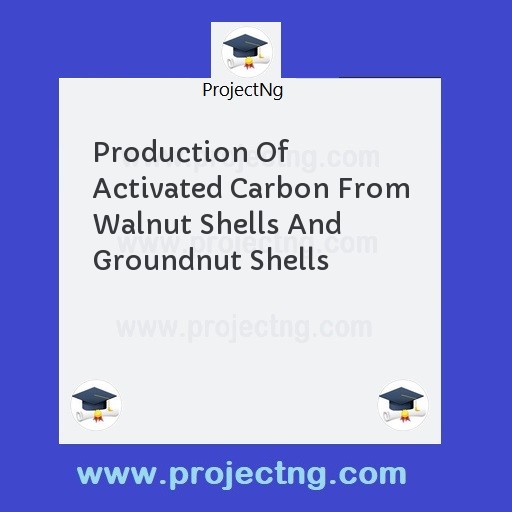Production Of Activated Carbon From Walnut Shells And Groundnut Shells
Science Lab Technology Project Topics
Get the Complete Project Materials Now! »
PRODUCTION OF ACTIVATED CARBON FROM WALNUT SHELLS AND GROUNDNUT SHELLS
ABSTRACT
Activated carbon is an effective fettering material, highly porous with immense surface area. Activated carbon removes many organic and some specific inorganic substances such as chlorine, cadmium, nickel, lead, and chromium from common industrial pollutants. Activated carbon was produced form walnut shell and groundnut shell by two major stages which are pyrolysis (carbonization) and activation using 1m H2SO4.It was found that the adsorption activity of activated charcoal increased with the combustion loss of the carbonization products. 80% and 92% yield of the activated carbon was gotten from groundnut shell and walnut shell respectively
CHAPTER ONE: INTRODUCTION
Active (activated) charcoals are also carbon adsorbents commonly used in industry for the adsorption of various substances from gaseous atmosphere and liquids. Thus, the use of activated charcoals is of considerable interest in the development of non waste technologies and environmental improvement (Fan et al, 2005).
Fossil coals, peat, various woods, paper and leather waste etc. are used as raw materials for manufacture of activated charcoal (Martinez et al, 2006).
Crushed (BAU) and powdered (OU) activated charcoals are produced from birchwood (Malik, 2004).
Activated charcoals are widely used in the food industry and machine for the purification of fruit syrups pharmaceutical, drinking water etc (Namasivayam and Kavithe, 2002).
High quality activated charcoals are prepared form coconut shells and fruits stones.
Walnut forest in the Kyrgyz republic are the largest natural growth walnut forests in the world. Therefore, the study of walnut shell as a raw material for the production of activated charcoal is of considerable theoretical and practical importance. This project is devoted to this problem of considerable current interest and reports the results of the experimental studies of walnut shells.
Activated carbon is an effective filtering material highly porous with immense surface area. The most common described activated carbon is that it acts like a sponge, sucking contaminant from liquid and gases (Okiemen et al, 2004). Activated carbon removes many organic and some specific inorganic substances such as chlorine, cadmium, nickel, lead and chromium from common industrial pollutants. Waste water from textile and tannery effluents attracts attention of environmental protection agencies all over the world. They not only deface the look of natural water, but are also highly toxic (Chu, 2001).
Some dyes are reported to harm mammalian cells by causing kidney tumors and reproductive difficulties (Fernendes et al, 1997; Henderson et al, 1997). These dyes are also potentially carcinogenic, genotoxic , Mutagenic in many animal species (Nimrat et al, 2004). Adsorption process is considered very effective in textile and tannery waste water treatment.
It proves superior to the other processes by being sludge free and can completely remove even very minute amounts of dyes in waste water (Nigarn et al, 1996). Adsorption processing commercial activated carbons is very effective for removal of dyes from waste water but its high cost has provided the search for alternatives and low cost adsobents.
Nickel and chromium which are widely used and extremely toxic in relatively low dosages, the main pathway through which nickel and chromium enters the water bodies via wastes from industrial processes. Heavy metals of concern in this work causes different ailment like cancer (Alluri, 2007).
The idea of using various agricultural waste products for the removal of heavy metals form waste water has been investigated by number of authors. Henderson et al,1997 have investigated the efficiency of number of different organic waste materials as adsorbent for heavy metals. Such adsorbents including coconut shell, peanut shell, rice lusk and groundnut shell have been considered for the adsorption of dyes. The use of activated carbons however has been widely considered because of their high adsorption on dyes.
Heavy metal pollution has become one of the most serious environmental problems today. Waste waters containing heavy metals are produced each year by textile industries and other processes. Most of the chemical methods used in clearing up of these heavy metals are not effective. Micro organisms have been used extensively in removing heavy metals from waste water. This necessitates the use of groundnut shell for adsorption of heavy metals. Groundnut shell is a carbonaceous, fibrous solid waste which encounters disposal problem and is generally used for its fuel value. Therefore, it was of interest to prepare a higher value product such as activated carbon from groundnut shell. Kinetic data and the adsorption mechanism of chromium and nickel onto the prepared activated carbons were studies using pseudo-first-order, pseudo-second-order, Elovich model and intraparticle diffusion model. The objectives are to evaluate the adsorption capacity of chromium and nickel at various contract time (30 to 150minutes), (Chen et al, 2003).
1.1 Statement of Problem
Activated carbon has been reported to be one of the indispensable material in chemical laboratory as well as industries because of its applications in refining of oil and adsorbent characteristics of it, this has prompted for a research work to be carried out on the production of activated carbon from locally available materials such as walnut shell and groundnut shells.
Be the First to Share On Social

Enjoying our content?
Don't miss out on new videos! Subscribe to our YouTube channel for more awesome content.
Subscribe Now!













